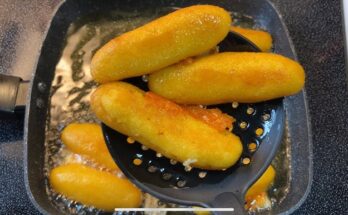Sun Tea Recipe: Imagine a lazy summer afternoon, the sun is high, and there’s a jug of tea slowly brewing on your porch. That’s sun tea for you—one of the simplest and most nostalgic beverages you can make at home. Sun tea is made by steeping tea bags in a container of water that’s placed directly in the sunlight. The warmth of the sun gently brews the tea over a few hours, creating a light, refreshing drink that’s perfect for hot days.
Unlike the traditional method where tea is brewed in boiling water, sun tea uses the slow heat of sunlight. This method is believed to draw out more subtle flavors and less bitterness, resulting in a mellow and naturally sweet drink. It’s a process that not only makes great tea but also creates a soothing ritual that feels like summer in a jar.
Why Choose Sun Tea Over Traditional Iced Tea?
So, why should you choose sun tea over the classic stovetop iced tea? First, it’s energy-efficient. No need to heat water—just let the sun do the work. It’s also a more hands-off process, allowing you to go about your day while the tea brews on its own.
Additionally, sun tea often has a softer, more delicate flavor compared to its boiled counterpart. The cooler brewing temperature helps preserve some of the subtle notes in the tea leaves that might get lost when steeped in boiling water.
And let’s be real—there’s just something special about sipping on a glass of tea that was brewed by nature. It adds an earthy charm and makes you feel connected to a simpler way of living. If you’re a fan of DIY drinks and minimal-effort recipes, sun tea is a must-try.
Ingredients and Supplies Needed
Basic Ingredients for Sun Tea
The beauty of sun tea lies in its simplicity. You only need a few basic ingredients to get started:
- Tea Bags: Choose your favorite type—black, green, herbal, or flavored blends.
- Filtered Water: Clean, cool, and chlorine-free water works best for fresh taste.
- Sweeteners (Optional): Sugar, honey, stevia, or agave syrup depending on preference.
- Fruits and Herbs (Optional): Add slices of lemon, orange, mint, or berries for extra flavor.
That’s it! No fancy equipment or hard-to-pronounce ingredients. The goal here is to keep things light, easy, and refreshing.
Equipment Checklist
Here’s what you’ll need to pull off the perfect sun tea setup:
- A Large Glass Jar (1- to 2-gallon): Mason jars work great, especially the ones with tight-fitting lids.
- Lid or Plastic Wrap: To keep bugs and debris out during the brewing process.
- A Spoon or Stirrer: For mixing in sweeteners or flavors after brewing.
- A Refrigerator: For chilling the tea once it’s done brewing.
- Strainer (Optional): If you’re using loose leaf tea or added fruits, you might want to strain it before serving.
Getting your ingredients and tools in place before starting makes the process seamless and enjoyable. Think of it as setting the stage for your tea to soak up the sun.
Choosing the Right Tea
Best Types of Tea for Sun Brewing
When it comes to sun tea, not all teas are created equal. Some varieties are more suited to the slow-brewing, low-temperature process that sun tea relies on. If you’re wondering which tea to choose, here are your best bets:
- Black Tea: This is the classic choice for sun tea. Brands like Lipton or Luzianne are fan favorites for their robust yet smooth flavor. Black tea provides that rich amber color and traditional iced tea taste we all know and love.
- Green Tea: If you want something a bit lighter and more refreshing, green tea is a solid option. It has a gentle, grassy flavor and offers antioxidant benefits.
- Herbal Tea: Caffeine-free and perfect for evening sipping, herbal teas like hibiscus, chamomile, mint, or rooibos add unique flavors and colors to your sun tea.
- Flavored Teas: Many store-bought teas come pre-infused with fruit or spices—like peach black tea or lemon green tea. These are excellent for variety without needing to add your own ingredients.
Avoid overly delicate teas like white or oolong unless you know how they respond to slow steeping. They can sometimes turn bitter or lose their complexity in the sun tea process.
Tips for Flavor Enhancements
Now, here’s where you can get creative. Once you’ve got your base tea, think about customizing the flavor to your taste:
- Citrus Zest: Add lemon, orange, or lime slices for a bright, zesty note.
- Fresh Herbs: Mint, basil, or rosemary can give your tea an herbal twist.
- Berries: Strawberries, raspberries, or blueberries infuse sweetness and color.
- Spices: A slice of fresh ginger or a cinnamon stick can add warmth and depth.
These add-ins can be placed directly into the jar with the tea bags during the brewing process. They’ll slowly infuse over time, giving your sun tea a flavorful edge. Just be sure to strain or remove them after steeping to avoid overpowering the drink.
Step-by-Step Sun Tea Brewing Process
Step 1: Fill the Jar with Water
Start with cold, filtered water to ensure your tea tastes clean and fresh. Avoid tap water that might contain chlorine or other impurities that could alter the flavor. Fill your clean glass jar about 3/4 full, leaving room for the tea bags and any extras like fruits or herbs.
Step 2: Add Tea Bags
A general rule of thumb is to use 1 tea bag for every 8 ounces (1 cup) of water. For a 1-gallon jar (128 ounces), that’s about 16 tea bags. However, if you prefer a stronger brew, you can add a few extra bags.
Tie the strings together and drape them over the edge of the jar so they’re easy to pull out later. You can also use loose leaf tea in a tea infuser or cheesecloth bag, but make sure it’s easy to remove afterward.
Step 3: Seal and Position in Direct Sunlight
Cover the jar with a lid or plastic wrap to keep out dust and bugs. Then, place it in a sunny spot—on your porch, a windowsill, or your backyard table. Make sure it gets direct sunlight for at least 3 to 5 hours.
The heat from the sun will slowly steep the tea, infusing it with flavor without boiling. This slow infusion brings out a mellow, less bitter taste.
Step 4: Brewing Time Guidelines
Typically, 3 to 5 hours of full sunlight is enough to make a flavorful batch of sun tea. The longer you leave it out, the stronger it becomes. If you’re using green or herbal tea, stick to the lower end to avoid over-steeping.
You don’t want to leave the tea out for too long (over 6 hours), as this increases the risk of bacteria forming—especially in hot weather.
Step 5: Remove Tea Bags and Add Flavors
Once your tea reaches the desired strength, bring the jar inside and remove the tea bags. Squeeze them gently against the side of the jar to get out every drop of flavor.
At this point, add any sweeteners—like sugar or honey—and stir well until dissolved. If you’re adding fruits, herbs, or spices for extra flavor, now’s the time. Let them steep in the jar for another 30 minutes at room temperature before refrigerating.
Safety Tips and Storage
How to Prevent Bacterial Growth
One of the most important things to remember when making sun tea is safety. Because sun tea brews at a lower temperature than boiling, it doesn’t get hot enough to kill potential bacteria that might be present in water, the tea bags, or the container. But don’t worry—there are simple precautions you can take to keep your tea safe and fresh.
- Use Clean, Filtered Water: Always use filtered or bottled water. Tap water can contain chlorine or other impurities that affect both taste and safety.
- Sterilize Your Jar: Before making your tea, wash the jar thoroughly with hot soapy water or run it through a dishwasher cycle to kill any bacteria.
- Keep It Out for No More Than 5 Hours: The longer tea sits in warm conditions, the higher the risk of bacterial growth. If your tea isn’t done after 5 hours, it’s better to move it inside and finish steeping it in the fridge.
- Refrigerate Immediately After Brewing: Once you’ve removed the tea bags and any add-ins, transfer your tea to the fridge. Bacteria multiply rapidly at room temperature.
Following these steps will ensure your sun tea is not only delicious but safe to drink, even after a few days in the fridge.
Proper Storage and Shelf Life
Storing sun tea correctly is just as crucial as brewing it. Once it’s been brewed and cooled, it should be placed in the fridge and kept tightly covered to maintain freshness and prevent contamination.
- Refrigerated Shelf Life: Sun tea can last up to 3 to 5 days in the refrigerator. Always store it in a clean, sealed glass container to prevent it from absorbing fridge odors or bacteria.
- Avoid Leaving It Out Overnight: Even if it smells and looks fine, unrefrigerated tea can harbor harmful bacteria like Alcaligenes viscolactis, which thrives in lukewarm environments.
- Check for Spoilage Signs: If your tea becomes cloudy, slimy, or develops an off smell, it’s time to toss it. It’s not worth the risk.
For best results, make smaller batches more frequently. Not only does this minimize waste, but it ensures your tea is always at peak freshness.
Serving Suggestions
Best Ways to Serve Sun Tea
Now that your sun tea is brewed, chilled, and safely stored—it’s time to enjoy it! There are plenty of fun and creative ways to serve this refreshing beverage.
- Over Ice: The classic way. Fill a tall glass with ice, pour in your sun tea, and enjoy. You can garnish with a lemon wedge or a sprig of mint for extra flair.
- With a Twist of Citrus: Squeeze a slice of lemon, lime, or orange into your tea for a zesty punch. Not only does it brighten the flavor, but it adds a touch of visual appeal.
- Sweetened or Unsweetened: Some people love their tea on the sweeter side. Try adding a dash of simple syrup, honey, or flavored syrup like peach or raspberry. Want to skip the sugar? Unsweetened sun tea has a clean, crisp taste all on its own.
- Fruity Fusion: Serve with fresh fruit inside the glass—blueberries, strawberries, or pineapple chunks turn your drink into a mini spa experience.
Whether you prefer it plain or packed with flavor, sun tea is one of those drinks that’s made to match your mood and personality.
Pairing Sun Tea with Meals
Sun tea isn’t just a standalone drink—it pairs beautifully with food. Its light and refreshing nature makes it a great accompaniment to various dishes, especially during the warmer months.
- BBQs and Grilled Meats: The smoky richness of grilled foods pairs well with the clean taste of sun tea, balancing heavy flavors with something cool and light.
- Salads and Light Lunches: A crisp Caesar salad or a turkey sandwich finds the perfect partner in a tall glass of sun tea.
- Brunch Favorites: Swap out sugary juices for sun tea served with waffles, eggs, or avocado toast.
- Spicy Foods: The natural sweetness of sun tea helps cool down the heat from spicy tacos, curries, or wings.
Sun tea is incredibly versatile, so don’t be afraid to experiment with different meals and see what you enjoy most. It’s a beverage that shines in just about any setting.
FAQs about Sun Tea Recipe
Can I Use Herbal Tea for Sun Tea?
Absolutely! Herbal teas like chamomile, hibiscus, or mint work wonderfully for sun tea. They’re caffeine-free, naturally sweet, and often produce vibrant colors and rich aromas.
How Long Can Sun Tea Stay in the Fridge?
Sun tea should be consumed within 3 to 5 days. Always keep it in the fridge in a tightly sealed container, and discard it if it turns cloudy or develops a funky smell.
Is Sun Tea Safe to Drink Daily?
Yes, sun tea is generally safe for daily consumption—just be sure it’s stored properly and not left at room temperature for long periods. Stick to clean ingredients and filtered water for best results.
Can I Make Sun Tea in the Winter?
Technically, yes—but it may take much longer to brew. In colder seasons or on cloudy days, you might prefer making a “cold brew” version in the fridge, which gives similar results with less risk of bacteria.
Why Does My Sun Tea Taste Bitter?
Bitterness usually comes from over-steeping or using too many tea bags. Try reducing the steep time to 3 hours and use fewer tea bags for a milder flavor. Green and black teas are more prone to bitterness if left in too long.
Conclusion
Making sun tea is more than just brewing a drink—it’s about enjoying the process, tapping into simplicity, and capturing the sunshine in a glass. This age-old method is a gentle reminder that not everything delicious needs to be rushed or complicated. With just a few basic ingredients and a bit of sunlight, you can create a flavorful, refreshing tea that outshines most store-bought versions.
Whether you’re a black tea traditionalist or an herbal tea experimenter, sun tea offers the perfect canvas for creativity. Add fruits, herbs, or spices to make it your own, and serve it however you like—over ice, with a splash of citrus, or lightly sweetened. And with the proper storage and safety precautions, your sun tea will stay fresh, clean, and completely sippable for days.
So go ahead—grab a jar, your favorite tea bags, and let the sun work its slow magic. Your perfect summer drink is just a few rays away.



